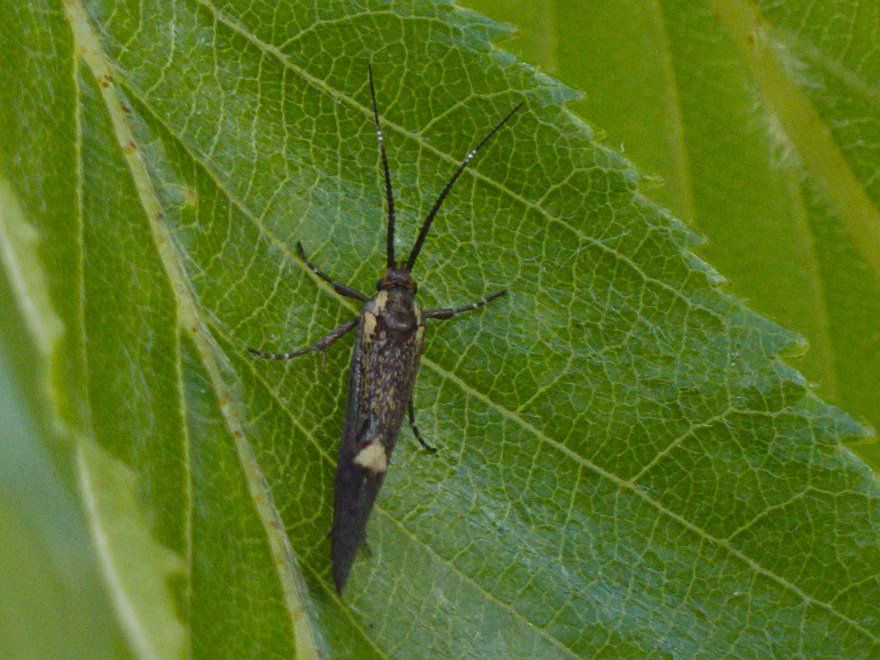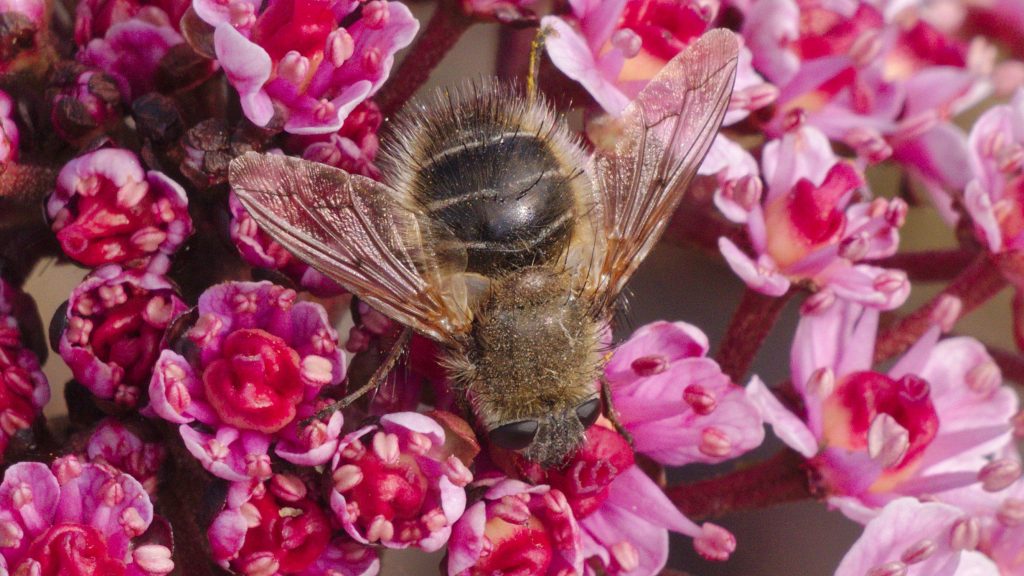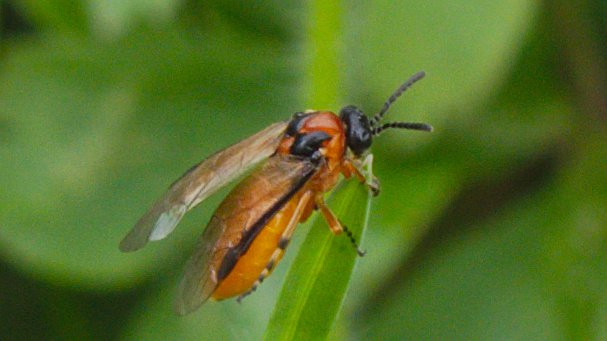
May 2019 was both wetter (72.8 mm, 143% of long-term average) and sunnier (188.9 hours, 167% of average) than usual. For the most part it was cool, and sometimes distinctly chilly — the lowest MAXIMUM temperature was only 7.9°C — brrr!!! — while the highest was only 21.3°C (lower than April’s) and the mean maximum was 14.7°C. On several nights the grass minimum temperature dipped below freezing, leading to ground frosts. The best weather was from 11th to 17th, which were dry and sunny; the month’s highest maximum temperature was in this spell. The month ended on a wet note, with the highest rainfall in any one day, 14.2 mm, being recorded on the penultimate day. Another six species were added to the Garden wildlife list, taking it from 1,085 to 1,091. They were two micro-moths, a sawfly, a true fly and two beetles.
Birds: Thirty-seven bird species were recorded at RBGE during May 2019 which, compared with some previous Mays, such as 2018, was rather uneventful. No unusual passage migrants, like last year’s Cuckoo and Redstart, were recorded. May 2019 did, however, bring the year’s first sightings of House Martin (15th) and Swift (seven dates from 15th to the end of the month). Swallow was not seen, though, so we did not yet have a summer, just as the weather told us! Black-headed Gulls were away all month on their breeding grounds and there were also no Kingfisher records, possibly for the same reason. Last month’s Collared Doves however remained until 1st at least and singing Chiffchaffs continued to hold several territories in the Garden all month. Nuthatches and Great Spotted Woodpeckers were reported on 9 and 19 dates respectively throughout the month; both species apparently bred. Tawny Owl was recorded on three occasions (10th, 14th and 31st) and Grey Heron on seven dates. There were also four sightings of Sparrowhawk spread throughout the month. The complete list of 37 species recorded during May 2019 was: Blackbird, Blackcap, Blue Tit, Bullfinch, Buzzard, Carrion Crow, Chaffinch, Chiffchaff, Coal Tit, Collared Dove, Dunnock, Feral Pigeon, Goldcrest, Goldfinch, Great Spotted Woodpecker, Great Tit, Greenfinch, Grey Heron, Herring Gull, House Martin, Jackdaw, Lesser Black-backed Gull, Long-tailed Tit, Magpie, Mallard, Moorhen, Nuthatch, Oystercatcher, Robin, Siskin, Song Thrush, Sparrowhawk, Swift, Tawny Owl, Tree Creeper, Wood Pigeon, Wren.
Mammals and amphibians: A Fox was seen on 11th. Palmate Newts were reported twice (14th and 31st).

Insects and other invertebrates: As in April, eight butterfly species were recorded during the month. They included two records of Large White (14th and 24th), a species that has been seen more often in the Garden in the last couple of years or so, possibly because more Brassicas (their larval food plant) are being grown in the Edible Garden. Other ‘whites’ included five sightings of Orange Tip between 1st and 24th, six of Green-veined White and three of Small White. Speckled Woods were seen on six dates between 1st and 24th. Peacock was recorded twice (2nd and 10th), Comma also twice (14th and 15th) and Red Admiral once (5th). However, unlike April, there were no records of Small Tortoiseshell. Five different daytime moths were seen in May. Two of them, Sulphur Tubic (recorded by Alan Crawford on 6th) and a Dichorampha species (probably Sharp-winged Drill, D. acuminatana) seen by Ken Dobson on 31st, were new Garden records. The other three were Fairy Longhorn (2nd), Grey Gorse Piercer (24th) and Diamond-back (24th). The more notable hymenopteran records were Turnip Sawfly (1st, 14th and 17th; new Garden record), Early Mining Bee (6th), Bugle Sawfly (23rd), and Marsham’s Nomad (several sightings from 1st, mostly around a nest-site of Chocolate Mining-bee which was also seen on several dates during May). All the commoner bumblebees were frequently seen, with fewer sightings of Honey Bee (four dates) and Common Wasp (five). Nine hoverfly species were recording during May. They included the year’s first sightings of Narcissus Bulb-fly (Merodon equestris f. equestris, which mimics some of the yellow-and black bumblebee species such as Buff-tailed) on 23rd, Xylota segnis (also 23rd) and Great Pied Hoverfly Volucella pellucens (24th). In contrast to April, Marmalade Hoverfly was recorded on four dates. One more fly species was added to the Garden’s list. This was the tachinid Tachina ursina which is rather brownish-grey and furry and somewhat resembles Common Carder Bee; this was seen in the Rock Garden on the same date (6th) by two different individuals. Its congener Tachina fera, a fly with an orange-red, black-striped abdomen, was seen on 14th; this seemed an unusually early record for this fly species which normally appears in the Garden during late summer and autumn. Flesh-flies (Sarcophaga sp.) were seen on 6th and 10th; these are virtually impossible to identify to species level, at least from photographs. St Mark’s Fly was recorded on the first three days of May and its relative, Lesser Variable Bibio, on 2nd. Some other flies seen during the month remain unidentified. Shield-bug records included Gorse Shield-bug (4th and 6th), Parent Bug (6th), Hawthorn Shield-bug (6th and 21st) and 2019’s first record of Forest Shield-bug (23rd). Other bugs reported were Common Pond Skater (10th), Frog-hopper (23rd, as ‘cuckoo-spit’) and Common Sycamore Aphid (also 23rd). Two new beetle species were added to the Garden list in May: the leaf beetle Chrysolina varians, which feeds on St John’s Wort, was seen mating on the label of Hypericum cerastioides at the bottom of the scree in the rock garden (2nd), and the longhorn beetle Grammoptera ruficornis (Common Grammoptera) was recorded on 23rd. Other records were of Figwort Weevil (6th onwards), Grey Sailor Beetle (21st and 24th), Garden Click Beetle (23rd) and the two usual poplar leaf beetles Phratora laticollis and P. vitellinae (both on 23rd, in much less quantity than last year). Seven-spot and Pine Ladybirds were also seen on several occasions. Spotted Wolf-spiders were recorded on three dates in the first week of the month in the Rock Garden and the galls of three gall-mites made their first appearances of the year on unfolding spring leaves of lime and sycamore. Boxwood spider mite was also recorded (23rd). Garden Snail was seen on 3rd and 31st and an atypical form of White-lipped Snail on 31st, while a pale fawn variant of the common ‘black slug’, Arion ater, or one of its close allies, was seen on 6th.

